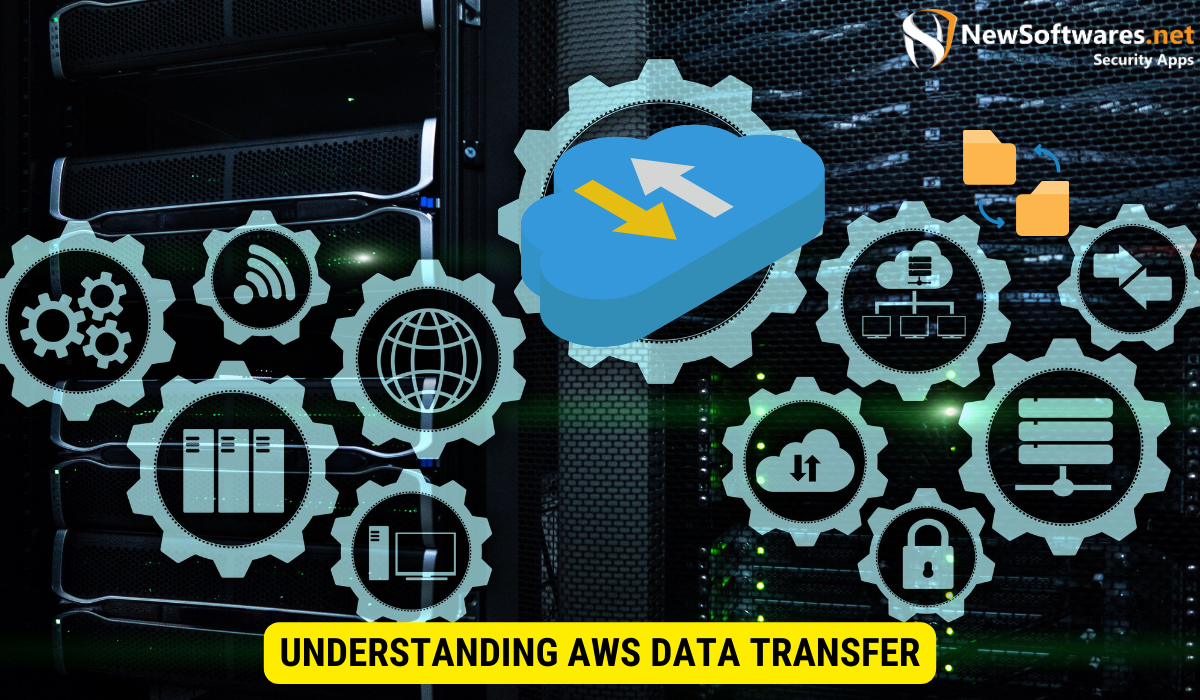Yes, transferring data to Amazon Web Services (AWS) can be encrypted. AWS emphasizes data encryption during the transfer process to ensure the security and integrity of the transmitted information.
Transferring data to Amazon Web Services (AWS) is a common practice for businesses and organizations of all sizes. However, ensuring the security and integrity of this data during transfer is of paramount importance. Together, we will explore the key concepts of AWS data transfer, the role of encryption in this process, the encryption methods used in AWS, the security protocols employed by AWS, the benefits of AWS encryption for data transfer, and address common concerns and misconceptions about this encryption.
Understanding AWS Data Transfer

Before diving into the encryption aspect of AWS data transfer, it is important to understand the fundamentals of this process. AWS data transfer refers to the transmission of data to and from AWS services, such as Amazon S3 or Amazon EBS. This transfer can occur between various sources, including on-premises data centers, internet-based applications, or other cloud providers. AWS provides robust and secure mechanisms to facilitate this data transfer, ensuring its confidentiality, integrity, and availability.
When it comes to AWS data transfer, there are several key concepts that are essential to comprehend. Firstly, data transfer can occur both within the same AWS region or between different regions. This flexibility allows organizations to distribute their data across multiple regions for redundancy and disaster recovery purposes. It also enables them to optimize data transfer performance by choosing the region closest to their users or applications.
Secondly, AWS offers various data transfer methods to cater to the different needs and requirements of users. These methods include direct network connections, internet-based methods, and offline data transfer options. Direct network connections, such as AWS Direct Connect, provide dedicated and private network links between on-premises environments and AWS. This ensures high-speed, low-latency, and secure data transfer. Internet-based methods, on the other hand, utilize secure protocols like HTTPS or VPNs to transfer data over the public internet. While these methods may not offer the same level of performance as direct network connections, they are more accessible and suitable for scenarios where dedicated connections are not feasible. Lastly, offline data transfer options, such as AWS Snowball or AWS Snowmobile, allow organizations to physically transfer large volumes of data by shipping storage devices to AWS data centers. This approach is particularly useful when dealing with massive datasets or limited internet bandwidth.
It is crucial to note that AWS data transfer encompasses both inbound and outbound traffic, ensuring a holistic approach to data movement within the AWS ecosystem. Inbound traffic refers to data being transferred into AWS services, while outbound traffic refers to data being transferred out of AWS services. This bidirectional data flow enables organizations to seamlessly integrate their existing infrastructure with AWS and leverage its scalable and flexible services.
The Role of Encryption in AWS Data Transfer
Encryption plays a pivotal role in securing data during its transfer to AWS. By encrypting data, organizations can protect sensitive information from unauthorized access or interception. AWS understands the criticality of encryption and offers robust mechanisms to safeguard data in transit.
When transferring data to AWS, organizations can encrypt their data using various encryption methods. One common method is to use SSL/TLS protocols to establish secure connections between the data source and AWS services. This ensures that data is encrypted while in transit, preventing eavesdropping or tampering. Another option is to use client-side encryption, where data is encrypted before being sent to AWS. This approach allows organizations to retain full control over the encryption keys, ensuring that only authorized parties can access the data.
On the AWS side, the services themselves also offer encryption capabilities. For example, Amazon S3 provides server-side encryption options, where data is automatically encrypted at rest using AWS-managed keys or customer-provided keys. This ensures that even if the data is stored in an unencrypted form, it remains protected. Additionally, AWS Key Management Service (KMS) allows organizations to centrally manage and control the encryption keys used by various AWS services, providing an added layer of security.
By employing encryption during data transfer, organizations not only ensure the confidentiality of the data but also enable themselves to demonstrate compliance with various regulatory requirements. Encryption is a fundamental aspect of data security, and AWS provides the necessary tools and features to help organizations protect their data throughout its entire lifecycle.
The Encryption Process in AWS
Understanding how AWS handles data encryption is essential for organizations looking to securely transfer their data. AWS employs a multi-layered approach to encryption, encompassing various stages of the data transfer process.
When transferring data to AWS, organizations can opt for client-side encryption or server-side encryption. In client-side encryption, the data is encrypted by the client before it is sent to AWS. This approach provides an additional layer of security as the encryption keys are managed by the client. On the other hand, server-side encryption involves AWS encrypting the data using its own encryption keys. Regardless of the chosen method, AWS ensures that the encryption process is seamless, efficient, and reliable.
Let’s delve deeper into how AWS handles data encryption and explore the different types of encryption options available.
Client-Side Encryption
Client-side encryption is a method where the data is encrypted by the client before it is transmitted to AWS. This approach provides organizations with full control over the encryption process. The client generates and manages the encryption keys, ensuring that only authorized parties can access the data. This added layer of security is particularly beneficial for organizations dealing with sensitive information.
When using client-side encryption, organizations can choose from various encryption algorithms, such as AES-256, to protect their data. These algorithms provide strong encryption, ensuring the confidentiality and integrity of the transferred data.
Server-Side Encryption
In server-side encryption, AWS handles the encryption process using its own encryption keys. This approach simplifies the encryption workflow for organizations, as they don’t have to manage the encryption keys themselves. AWS uses industry-standard encryption algorithms, such as AES-256, to encrypt the data, ensuring its security during transfer.
With server-side encryption, organizations can choose between different AWS services that provide encryption capabilities. These services include Amazon S3, Amazon EBS, and Amazon RDS, among others. AWS manages the encryption keys securely, allowing organizations to focus on their core business operations while ensuring the confidentiality of their data.
Types of Encryption Used in AWS
AWS offers various encryption options, allowing organizations to select the most suitable method based on their specific requirements. These options include:
- AES-256 Encryption: AWS provides native support for Advanced Encryption Standard 256-bit encryption. This robust encryption protocol ensures the confidentiality and integrity of the data during transfer. AES-256 is widely recognized as a secure encryption algorithm and is used by organizations worldwide to protect their sensitive information.
- Transport Layer Security (TLS): TLS is an industry-standard protocol for securing data during transmission over computer networks. AWS employs TLS to encrypt data both between AWS services and between AWS and external endpoints. By using TLS, organizations can ensure that their data remains secure and protected from unauthorized access during transit.
- Key Management Service (KMS): AWS Key Management Service enables organizations to manage and control the encryption keys used to encrypt and decrypt their data. KMS integrates seamlessly with various AWS services, providing a centralized key management solution. With KMS, organizations can create, rotate, and disable encryption keys, ensuring the security of their data throughout its lifecycle.
By offering these encryption options, AWS empowers organizations to choose the most appropriate method for their specific use cases. Whether it’s client-side encryption for added control or server-side encryption for simplified management, AWS ensures that data remains secure and protected throughout the transfer process.
Security Measures in AWS Data Transfer
AWS employs several security protocols and measures to bolster the security of data during transfer. These protocols not only protect the confidentiality of the data but also ensure its integrity and availability.
AWS Security Protocols for Data Transfer
From a network security perspective, AWS leverages Virtual Private Cloud (VPC) to isolate resources and provide secure communication channels. Additionally, AWS implements strict access controls and authentication mechanisms to prevent unauthorized access to data during transfer. Furthermore, AWS utilizes advanced network encryption protocols, such as IPsec and TLS, to secure data in transit.
Ensuring Data Integrity in AWS
Ensuring data integrity is crucial to maintaining the trustworthiness of the transferred data. AWS accomplishes this through various mechanisms, such as checksums and hash functions, which verify the integrity of the data before and after transfer. These measures help detect and prevent any data tampering or corruption during transit, providing organizations with peace of mind regarding the integrity of their data.
Benefits of AWS Encryption for Data Transfer
The utilization of AWS encryption for data transfer offers several compelling benefits for organizations seeking to enhance their data security posture.
Enhanced Security with AWS Encryption
By encrypting data during transfer, organizations can bolster their security stance and mitigate the risk of data breaches or unauthorized access. Encryption ensures that even in the event of data interception, the information remains unreadable, maintaining the confidentiality of sensitive data.
Compliance and Regulatory Advantages

Many industries and jurisdictions have stringent compliance and regulatory requirements regarding data privacy and protection. Compliance with these requirements is essential for organizations to maintain their reputation and avoid legal and financial ramifications. AWS encryption provides a robust foundation for meeting these compliance obligations, enabling organizations to demonstrate their adherence to industry standards and regulations.
Common Concerns and Misconceptions about AWS Encryption

Despite the clear advantages of AWS encryption for data transfer, there are common concerns and misconceptions that need to be addressed.
Addressing AWS Encryption Myths
One common myth is that encryption slows down data transfer. While encryption does introduce additional processing overhead, AWS has implemented efficient encryption algorithms that minimize any performance impact. The benefits of encryption in terms of data security far outweigh the minimal impact on transfer speed.
Overcoming Encryption Challenges in AWS
Another concern is the complexity and management overhead associated with encryption in AWS. However, AWS provides robust documentation, tutorials, and tools to simplify the encryption process and alleviate any concerns about the management burden. Additionally, AWS Key Management Service offers a centralized solution for managing encryption keys, streamlining the encryption workflow.
Key Takeaways
- AWS Data Transfer Fundamentals: Bidirectional data flow, diverse transfer methods, and intra/inter-region transfers are core concepts.
- Role of Encryption: Encryption secures data, ensures compliance, and dispels myths about its impact on transfer speed.
- Encryption in AWS: AWS employs TLS, client-side, and server-side encryption methods using robust encryption algorithms like AES-256.
- Security Measures: VPC isolation, access controls, encryption protocols, and data integrity verification fortify AWS data transfer security.
- Benefits and Misconceptions: Enhanced security, compliance adherence, and AWS’s encryption management tools counter concerns about performance impact and complexity.
